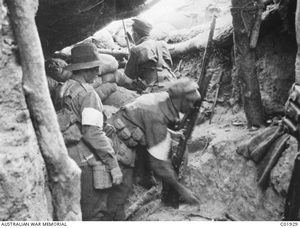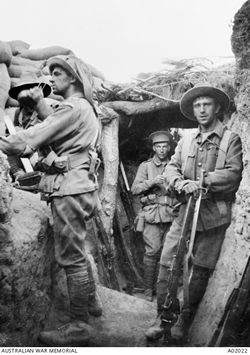English Stage 4
Overview

Three 7th Battalion men standing at a bomb stop at the old Turkish firing line in Lone Pine, 9 August 1915
©Public domain (AWM C01929)
Students explore the First World War origins of words and phrases commonly used today. They use Google Ngram Viewer to plot the frequency of some of the ‘trench talk’ words. Students analyse the results and write a brief history of one word’s usage.
Teaching and learning activities

Australian troops in the Turkish Lone Pine trenches, captured on the afternoon of the 6 August 1915 by the AIF 1st Brigade under Brigadier-General Walker
©Public Domain (AWM A02022)
How does language usage evolve for new contexts and purposes?
Resources:
Activities can be completed on PC, but are easily accessible on tablets and smart phones.
-
Students read the article The trench talk that is now entrenched in the English language.
-
As a class, students discuss three questions:
-
How do the words and phrases in the article reflect soldiers’ experiences in the trenches?
-
Which of these words seem most familiar to you now and how might you use these words in English today?
-
What is the relationship between today’s usage and the usage in the trenches?
-
-
Ask students to make a list of all words in the article that are said to have been adopted or popularised during the First World War.
-
Ask students if anyone can explain the function of Google Ngram. Explain that it charts the history of the language usage in texts loaded to Google Books.
-
Using Google Ngram Viewer students examine the usage of the words and phrases they have listed from the article. NB: To keep the results readable, enter about five words per search.
-
Students identify the most popular words and estimate the year that these began to appear in published works.
-
In class discussion, ask students to describe the relationship between usage described in the article and the data mapped in Ngram Viewer. The following questions can provide a focus:
-
Which words seem to have come into existence after 1914?
-
Which words have maintained popularity?
-
Which words have interesting patterns of usage, and what possible explanations might there be for these patterns?
-
-
Students choose one of the listed words each and write a brief informal history of the word’s usage, referencing both the Ngram Viewer chart and etymology provided.
Learning concepts
These additional questions can be used for discussion or further investigations.
Challenge
What words and phrases have originated from the challenges faced by soldiers in the trenches? Does current usage reflect the challenges?
Change
What words and phrases have origins in the soldiers’ experiences in the trenches?
What is the relationship between today’s usage and the usage in the trenches?
Which words seem to have come into existence after 1914? Which words have maintained popularity?
Syllabus links
EN4-1A responds to and composes texts for understanding, interpretation, critical analysis, imaginative expression and pleasure
-
identify and evaluate devices that create tone, for example humour, wordplay, innuendo and parody in poetry, humorous prose, drama or visual texts
EN4-2A effectively uses a widening range of processes, skills, strategies and knowledge for responding to and composing texts in different media and technologies
-
analyse and explain how language has evolved over time and how technology and the media have influenced language use and forms of communication
EN4-3B uses and describes language forms, features and structures of texts appropriate to a range of purposes, audiences and contexts
-
understand the ways etymology can clarify choice of vocabulary